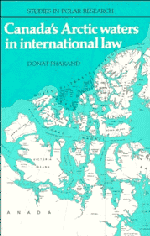Book contents
- Frontmatter
- Contents
- Figures
- Tables
- Foreword
- Preface
- Acknowledgements
- Part 1 The Waters of the Canadian Arctic Archipelago and the Sector Theory
- Part 2 The Waters of the Canadian Arctic Archipelago as Historic Waters
- Part 3 The Waters of the Canadian Arctic Archipelago and Straight Baselines
- Part 4 The Waters of the Canadian Arctic Archipelago and the Northwest Passage
- Notes
- General Conclusion
- Appendix A The 1825 Boundary Treaty, Great Britain and Russia
- Appendix B The 1867 Boundary Treaty, United States and Russia
- Selected bibliography
- Index
Part 3 - The Waters of the Canadian Arctic Archipelago and Straight Baselines
Published online by Cambridge University Press: 20 January 2010
- Frontmatter
- Contents
- Figures
- Tables
- Foreword
- Preface
- Acknowledgements
- Part 1 The Waters of the Canadian Arctic Archipelago and the Sector Theory
- Part 2 The Waters of the Canadian Arctic Archipelago as Historic Waters
- Part 3 The Waters of the Canadian Arctic Archipelago and Straight Baselines
- Part 4 The Waters of the Canadian Arctic Archipelago and the Northwest Passage
- Notes
- General Conclusion
- Appendix A The 1825 Boundary Treaty, Great Britain and Russia
- Appendix B The 1867 Boundary Treaty, United States and Russia
- Selected bibliography
- Index
Summary
The straight baseline system of delimiting territorial waters was developed by Norway, beginning with its first Royal Decree of 1812. The system was approved by the International Court in 1951, and incorporated in the Convention on the Territorial Sea of 1958 and in the Law of the Sea Convention of 1982. Under this system, where a coast is deeply indented or is bordered by an Archipelago, it is permissible to draw straight baselines, across the indentations and between the outermost points of the islands, from which the territorial sea is measured. This geographic situation is commonly referred to as that of a coastal Archipelago.
At the Third Law of the Sea Conference, the applicability of the straight baseline system was extended to mid-ocean or oceanic Archipelagos. These are situated at such a distance from any mainland as to be considered an independent whole and constitute the national territory of a State called an Archipelagic State. Off-lying and oceanic Archipelagos forming an integral part of the territory of a continental State are not specifically provided for in the 1982 Convention.
In 1974, a group of nine States introduced a Working Paper proposing the right for a coastal State, with an off-lying Archipelago forming an integral part of its territory, to apply the straight baseline system to such an Archipelago, subject to the right of innocent passage. Also in 1974, Ecuador proposed that straight baselines be applicable ‘to Archipelagos that form part of a State, without any change in the natural regime of the waters of such Archipelagos or of their territorial sea’.
- Type
- Chapter
- Information
- Canada's Arctic Waters in International Law , pp. 131 - 132Publisher: Cambridge University PressPrint publication year: 1988

